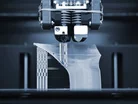14Trees hits milestone on Kenyan 3D printed housing project

14Trees, a joint venture company between cement and concrete giant Holcim and British International Investment (the UK Government’s impact investor), has announced the initial results of their efforts to 3D print up to 52 houses in Kilifi, Kenya, using a single BOD2 printer from COBOD.
In a statement, the joint venture, which is behind the first 3D printed houses in Africa, and the first 3D printed schools in the world, said that it had started work on the project in October 2022, and that it has completed the 3D printing the first 10 houses at the Kenyan housing complex in January 2023. The project hit this milestone after just 10 weeks and using only one printer.
14Trees added that it intends to get the full benefit of the large-scale project by experimenting and innovating over the course of the progression of the project, which is known as Mvule Gardens. Building on 14Trees' world-first 3D-printed school in Malawi, the 52-house complex is scaling up affordable housing in Kenya to help bridge the country’s infrastructure gap and deliver affordable, climate-friendly homes at scale.
The next phases will consist of 10 to 15 houses each, with several innovations included that will allow future tenants to design their homes and move away from the standardised 3D printed approach to one which fully leverages the technology’s customisation possibilities, it highlighted.
It added that the cost of construction will be an area of focus for the next phases, as with each phase, it intends to lower construction costs further, such that the build cost is 20% lower than standard houses. By using Holcim’s proprietary 3D printing materials, TectorPrint, which is made at a local plant, there has already been a significant reduction in costs, the statement continued.
Francois Perrot, Managing Director of 14Trees said: “With 3D printing, you can solve two problems at once. You can build faster like we have shown here with our 10 houses in 10 weeks. At the same time, we can achieve better cost efficiency, which will help make affordable housing a reality for the majority. In addition, you can build with less materials, which preserves the resources of the planet for future generations.”
Impressive Performance
As per the company’s website, the house walls can be printed with 12 to 18 hours, which allows for the fast execution of the project. Furthermore, the CO2 emissions can be reduced by to 70% when compared to conventional construction methods. Finally, the use of 3D printing methods can deliver up to 20% savings on construction costs, it added.
Miljan Gutovic, Region Head for Europe at Holcim, said: “I am very proud of the work done by 14Trees in Africa, where their innovations in 3D printing technology are accelerating affordable and sustainable building. I look forward to 14Trees replicating these successes in Europe and other parts of Africa in the very near future.”
The project’s advanced sustainability profile has attained an EDGE Advanced sustainable design certification by IFC, the World Bank's development finance institution, which recognises resource-efficient buildings with the potential to be zero-carbon. It is the first time a 3D-printed housing project has attained this certification.
14Trees is using a 3D printer capable of building structures more than 10 meters long. TectorPrint is flexible and can adapt to a wide variety of needs, which enables the fast construction of affordable and sustainable homes at scale. The new technology also supports the creation of highly-skilled jobs, with local workers being trained as 3D machine assistants and specialists.
Commenting on the performance of 14Trees, Philip Lund-Nielsen, Head of COBOD Americas, stated: “Considering how difficult the conditions are in Africa, it is impressive, that 14Trees has printed more houses on a single site, than any other construction 3D printing company in the US or elsewhere.
“In addition, they have done it faster, using just a single COBOD 3D printer not by using 5 printers or more,” he concluded.
- Skanska & Holcim Lead way on Sustainable Roads ConstructionBuilt Environment
- Holcim & Neustark Partner on Construction Carbon CaptureSustainability & Green Building
- Top 10: Largest Construction Material ManufacturersPlanning & Design
- Cemex Holcim Acquisition Hits European Commission BarrierFacilities Management



